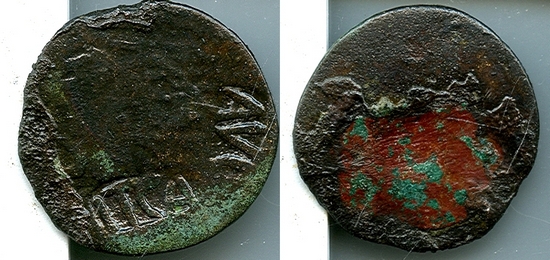The greyish material is something like cement. It would not yield to zapping. My DDDP would not scratch it one bit. Where the green encrustation isn't on the left scan, it was covered with the grey stuff.
The right scan was partially covered with the grey stuff. I also tested the disc in the flat area between the two countermarks. I let it sit in one spot for about 20 seconds. It did not cut into the metal.
So, this could be a very good item to use as a finishing tool when grinding encrustations. The diamond tools that I have used to grind encrustations would easily dig into the metal. If I slipped, it would dig a deep gouge into the coin. This seems safe on the metal at least.
Although it easily eats through the grey cement, it doesn't fare too well against this green encrustation. My DDDP doesn't scratch it either. On the left scan, you can see where I was trying to grind it down.Towards the top right of the coin, a couple mm in, you can see where the encrustation is shiny. I got through perhaps 1mm of it, but then it seemed to be melting it, instead of grinding. Perhaps I need a cooling agent, or perhaps just grind it down with a diamond tool, then finish it with the radial bristle.
Although the scan really doesn't show it, there are details visible in the fields that I used this on (left scan).
I believe I have definitely found a good tool here, and will experiment more with the different grits.

The diamond tools I have slid right off of the encrustation of the reverse. I pulled out my set of trusty Ceramcuts by Foredom (ceramic compared to metal material, Dremel tools, very sweet! They don't overheat like normal metal bits and last 5x as long). It ground the encrustation with ease, but alas, the encrustation went well below the surface of the coin. I stopped after most of it was gone. I used the 6 micron radial wheel to clean up any loose debris, soaked it in 91% alcohol, then repatinaed it with Jax. In hand, the obverse is very nice looking with a rich brown "patina", and as an added bonus, the green coloring around the countermarks.
I have another coin with this grey cement, so am going to try the 240 grit on it when it arrives.
